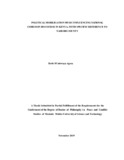| dc.description.abstract | Music and society have always been intimately related. Music reflects and creates social
conditions including the factors that either facilitate or embed social change. Political
mobilization music influences the levels and status of national cohesion. Some music can
bring about peaceful coexistence and others can cause conflict. Scholars have researched
and written Music for environmental, social and cultural purposes. However, PMM
which is known to trigger conflict or foster national cohesion has been neglected yet
during general elections, alignments has been evident due to PMM (Abayomi 2011). The
study sought to examine how political mobilization music influence national cohesion
discourse in Kenya, with specific reference to Nairobi County as a general objective. The
specific objectives were to examine the nature and evolution of political mobilization
music in Post-colonial Kenya, assess the influence of Political Mobilization Music
(PMM) on status and levels of national cohesion and examine the challenges inherent in
employing political mobilization music towards national cohesion. The study was based
on the conceptual framework informed by three theories; Critical Race Theory (CRT),
Music Meaning Theory and a Just Peace Theory. The research adopted descriptive
research design with mixed method approach, utilizing both primary and secondary data.
The study population consisted of 1015 citizens, political mobilization musicians and
government officials. The sample size was 156 respondents. Data for the study was
collected using questionnaires, FGDs and in-depth interviews with key informants.
Quantitative data was analyzed using descriptive statistics and presented in tables, pie
charts, graphs while qualitative data were analyzed using qualitative methods with
specific reference to SPSS, cross-tabulation and Excel presented in description. Analysis
of the results showed that the nature of political mobilization music were praise,
demonizing, idolizing, patriotic and solidarity songs. Evolution of PMM took place from
precolonial era (1963-1982) with solidarity and patriotism, Nyayo era (1982 – 1992) with
praising and idolizing songs, multiparty era (1992-2000) with praising, idolizing and
demonizing songs and Millennium age (post 2000) with demonizing songs and tribal
alignment music. On the status of national cohesion, it was a two-sided coin, with
positive and negative peace in Nairobi County, while the levels of national cohesion were
very high. Key challenges inherent in employing PMM towards national cohesion is that
the National Cohesion and Integration Commission, Kenya Music Festival, Music
Copyright Society of Kenya have minimum powers in regulating music songs. This
attributed to lack of clear policies on punishing people with hate speech. The findings
showed that the influence was on two folds both negative and positive depending on the
nature of songs composed and sang. It is recommended that composition of National
patriotic songs is a one special way of branding the country to the rest of the world.The
findings of this study will contribute to the existing knowledge and formulation of state
policies on the political mobilization music influencing national cohesion in Kenya and
benefit particularly peace workers. | en_US |

